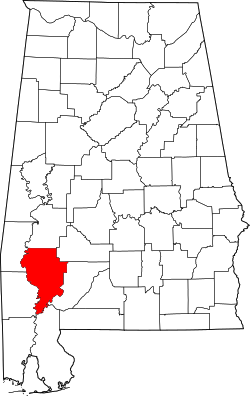Clarke County, Alabama
![Clarke County Courthouse is a Contributing Property in the Grove Hill Courthouse Square Historic District, listed on the NRHP since April 1998. [1]](https://upload.wikimedia.org/wikipedia/commons/thumb/e/e1/Clarke_County_Courthouse.jpg/298px-Clarke_County_Courthouse.jpg) Clarke County Courthouse is a Contributing Property in the Grove Hill Courthouse Square Historic District , listed on the NRHP since April 1998. |
|
| administration | |
|---|---|
| US state : | Alabama |
| Administrative headquarters : | Grove Hill |
| Address of the administrative headquarters: |
County Courthouse P.O. Box 548 Grove Hill, AL 36451-0548 |
| Foundation : | December 10, 1812 |
| Made up from: | Washington County |
| Area code : | 001 |
| Demographics | |
| Residents : | 25,833 (2010) |
| Population density : | 8.1 inhabitants / km 2 |
| geography | |
| Total area : | 3244 km² |
| Water surface : | 37 km² |
| map | |
| Website : www.clarkecountyal.com | |
The Clarke County is a county in the state of Alabama of the United States . At the 2010 census , the county had 25,833 people and a population density of 9 people per square kilometer. The county seat is Grove Hill . The county is part of the dry counties , which means that the sale of alcohol is restricted or prohibited.
geography
The county is located almost in the extreme southwest of Alabama, about 40 km to the west from Mississippi , about 60 km to the south from Florida and has an area of 3,244 square kilometers, of which 37 square kilometers are water. It is bordered clockwise by the following counties: Marengo County , Wilcox County , Monroe County , Baldwin County , Washington County, and Choctaw County .
history
The area has been claimed by both the Choctaw people and the Creek , using the watershed of the Alabama and Tombigbee rivers as a boundary. The first white settlements arose on these two rivers . Clarke County was formed on December 10, 1812 by resolution of the Mississippi Territory government from parts of Washington County. It was named after either John Clark or Elijah Clarke (1733–1799). The latter was a general in the Continental Army during the American Revolutionary War and fought in the siege of Augusta in 1781. His son John Clark served as a general in the British-American War and served as governor of Georgia . He removed the e as an ending from the family name. The first county seat was Clarksville, which became Grove Hill in 1831. In the Creek War of 1813/14 , these settlers built forts to protect against the Indians. In an attack on Fort Sinquefield in September 1813, the Creek killed several settlers. Two months later, Samuel Dale led a squad of 30 men against the Indians, with a skirmish broke out in the Alabama River that became known as the "Canoe Fight". In the Treaties of Fort Jackson (1814) and Dancing Rabbit Creek (183), Creek and Choctaw ceded their land to the United States, respectively. During the Civil War , the county provided ten companies for the Confederate Army and was a supplier of salt and wood. The forest industry remained an important economic factor in the county after the civil war, helped by the railroad construction in Alabama.

21 structures and sites in the county are listed on the National Register of Historic Places (NRHP) as of March 31, 2020, including the Alston-Cobb House , Fort Sinquefield and the Grove Hill Courthouse Square Historic District .
Demographic data
| growth of population | |||
|---|---|---|---|
| Census | Residents | ± in% | |
| 1820 | 5839 | - | |
| 1830 | 7595 | 30.1% | |
| 1840 | 8646 | 13.8% | |
| 1850 | 9786 | 13.2% | |
| 1860 | 15,049 | 53.8% | |
| 1870 | 14,663 | -2.6% | |
| 1880 | 17,806 | 21.4% | |
| 1890 | 22,024 | 23.7% | |
| 1900 | 27,790 | 26.2% | |
| 1910 | 30,987 | 11.5% | |
| 1920 | 26,409 | -14.8% | |
| 1930 | 26,016 | -1.5% | |
| 1940 | 27,636 | 6.2% | |
| 1950 | 26,548 | -3.9% | |
| 1960 | 25,738 | -3.1% | |
| 1970 | 26,724 | 3.8% | |
| 1980 | 27,702 | 3.7% | |
| 1990 | 27,240 | -1.7% | |
| 2000 | 27,867 | 2.3% | |
| 2010 | 25,833 | -7.3% | |
| Before 1900
1900–1990 2000 2010 |
|||

Clarke County had a population of 27,867 people as of the 2000 census . 387 of these people lived in collective accommodation, the other residents lived in 10,578 households and 7,700 families. The population density was 9 people per square kilometer. The racial the population was composed of 55.94 percent white, 43.02 percent African American, 0.22 percent Native American, 0.16 percent Asian and 0.16 percent from other ethnic groups; 0.49 percent were descended from two or more races. Hispanic or Latino of any race was 0.65 percent of the population.
Of the 10,578 households, 35.4 percent had children and adolescents under the age of 18 living with them. There were married couples living together in 53.9 percent, 15.7 percent were single mothers, 27.2 percent were not families, 25.5 percent of all households were single households and 11.9 percent had people aged 65 and over or above. The average household size was 2.60 and the average family size was 3.13.
28.0 percent of the population were under 18 years old, 8.5 percent between 18 and 24, 27.5 percent between 25 and 44, 22.5 percent between 45 and 64 and 13.5 percent were 65 years or older. The median age was 36 years. For every 100 females there were 89.7 males and for females aged 18 and over there were 84.6 males.
The median income for a household in the 27,388 USD , and the median income for a family 34,546 USD. Males had a median income of $ 34,111 versus $ 19,075 for females. The per capita income was $ 14,581. 18.1 percent of families and 22.6 percent of the population lived below the poverty line.
Places in the county
- Alma
- Atkeison
- Barlow Bend
- Bashi
- Campbell
- Carlton
- Center Point
- chance
- Chilton
- Choctaw Bluff
- Clarksville
- Coffeeville
- Cunningham
- Dickinson
- Failetown
- Finley Crossing
- Fulton
- Gainestown
- Glover
- Gosport
- Greenwood
- Grove Hill
- Jackson
- Manila
- Mays Crossroads
- McEntyre
- McVay
- Midway
- Morvin
- Nettleboro
- Opine
- Peacock
- Rock Springs
- Rockville
- Roundhill
- Rural
- Salitpa
- Scyrene
- Smyer
- Springfield
- Suggsville
- Tallahatta Springs
- Tattlersville
- Thomasville
- Toddtown
- Vashti
- Walker Springs
- West Bend
- Whatley
- Winn
- Woods Bluff
- Zimco
See also
literature
- Thomas McAdory Owen: History of Alabama and Dictionary of Alabama Biography. SJ Clarke Publishing Co., Chicago IL 1921.
- Virginia O. Foscue: Place Names in Alabama. University of Alabama Press, Tuscaloosa et al. 1989, ISBN 0-8173-0410-X .
- Joyce White Burrage: Clarke County, Alabama . Arcadia Publishing, Charleston SC 1998, ISBN 0-7524-0400-8 , ( Images of America ).
- Tom Franklin: Hell at the Breech. A novel . Harper Perennial, New York NY 2003, ISBN 0-06-056676-0 , (German edition: Die Gefürchteten. Roman . From the American by Wolfgang Müller. Heyne, Munich, 2005, ISBN 3-453-01210-0 ).
Individual evidence
- ^ Grove Hill Courthouse Square Historic District on the National Register Information System. National Park Service , accessed July 1, 2020.
- ↑ GNIS-ID: 161538. Retrieved on February 22, 2011 (English).
- ↑ Clarke County at Alabama.gov ( April 3, 2014 memento in the Internet Archive )
-
↑ Charles Curry Aiken, Joseph Nathan Kane: The American Counties: Origins of County Names, Dates of Creation, Area, and Population Data, 1950-2010 . 6th edition. Scarecrow Press, Lanham 2013, ISBN 978-0-8108-8762-6 , p. 59.
Patricia Hoskins Morton: Clarke County. In Encyclopedia of Alabama, July 5, 2007, last updated August 29, 2019, retrieved July 1, 2020. - ^ Alston-Cobb House in the National Register Information System. National Park Service , accessed July 1, 2020.
-
↑ Search mask database in the National Register Information System. National Park Service , accessed March 31, 2020.
Weekly List on the National Register Information System. National Park Service , accessed March 31, 2020. - ↑ US Census Bureau - Census of Population and Housing . Retrieved March 15, 2011
- ↑ Extract from Census.gov . Retrieved February 28, 2011
- ^ Population of Clarke County - Alabama
- ↑ Excerpt from census.gov ( Memento from May 17, 2014 in the Internet Archive ). Retrieved March 31, 2012
- ↑ Fort Sinquefield on the National Register Information System. National Park Service , accessed July 1, 2020.
- ^ Population of Clarke County - Alabama
Web links
- Clarke County in the Encyclopedia of Alabama
Coordinates: 31 ° 40 ′ N , 87 ° 50 ′ W

